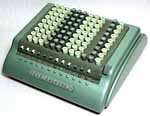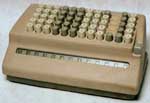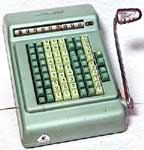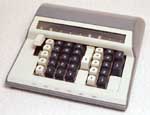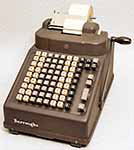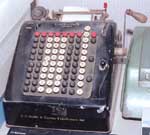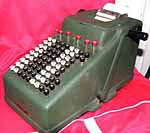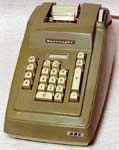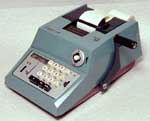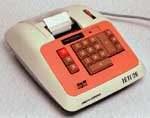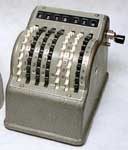Home > Non-Decimal Calculators > Sterling Currency Calculators
Sterling Currency Calculators
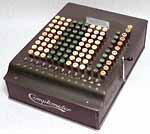
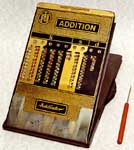
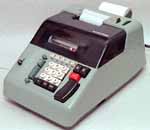
Before 1971 Britain had an unusual non-decimal money system.
Britain's Sterling (£sd) money system before 1971 was not decimal, but was based on the centuries-old Pound, Shilling, & Penny, where :-
12 Pennies (Pence) = 1 Shilling
20 Shillings = 1 Pound
So 1 Pound = 240 Pence
This may seem a little strange now, but when taught from a very early age it came naturally. Also it did have a few advantages, for example it was easy to split one Pound exactly between 3 people - each one would be given 6 Shillings and 8 Pence - also 1 pound could be split exactly into 4, 5, 6, 8, etc.
The way of writing a price in this system was easy - for example, a sum of money comprising 21 Pounds 15 Shillings and 11 Pence would be written £21 15s. 11d. (or £21/15/11).
Several other countries, mainly from the British Commonwealth, had also used a similar monetary system but all changed to decimal systems by 1972.
As can be imagined, this non-decimal system caused difficulties when calculating, especially multiplying and dividing - for example see the article "Sterling Currency (£sd)
Multiplication on a 12-key Add-Lister".
It was possible to use a standard decimal calculator by using tables to convert from Shillings and Pence to fractions of a Pound and vice versa.
However, special versions of the simpler calculators (Comptometers, adding machines, add-listers, and addiators) were made which worked in Pounds, Shillings, & Pence.
Types of Sterling Currency Calculators on this page -
The Comptometer was the first succesfull key driven adding and calculating machine.
"Key driven" means that just pressing the keys adds the numbers entered to the total - no other action is required - so it is very quick for adding long lists of numbers.
It was invented by the American Dorr E. Felt in 1884, and produced by the Felt & Tarrant Manufacturing Company.
Its basic function is addition. There is a column of keys (in general 1-9) for each decade. When a key is pressed, that number is added to that decade, with carry to the next higher decade, if applicable. Pulling the handle forwards clears the total to zero.
Subtraction, multiplication, and division are also possible on Comptometers using special techniques - For examples see the bottom of the page on Christofer Nöring's site archived at https://web.archive.org/web/20200215144501/http://w1.131.telia.com/~u13101111/comp.html.
"Comptometer" eventually became to be used as a generic name for calculators of this type from all manufacturers.
Standard decimal Comptometers have all columns identical with 9 keys in each (no key is required for 0).
The examples illustrated are versions for £sd Sterling currency with non-standard numbers of keys in some columns.
"Comptometer" type machines with their full keyboards are large, take up a lot of desk space, and the basic machine does not provide a printed record of the calculations. For adding lists they are very fast since only the number keys need to be pressed and all the fingers can be used to enter multiple digits simultaneously.
They also appear to be very reliable.
"Comptometer" type machines were the main-stay of many accounting and wage departments since they were very quick and efficient for adding up lists of numbers.
Well into the 1970s job vacancies for "Comptometer Operators" were advertised.
Click on an image for a larger picture and technical details
Full keyboard adding machines (add-listers) have a column of keys (in general 1-9) for each decade and display the numbers entered and the total only on the printed paper roll.
When a key in any decade is pressed it locks in - only one key in each decade can be locked in.
Pulling the handle forward prints the number represented by all the depressed keys on the listing paper and adds it to the accumulator.
Pressing the "total" key and pulling the handle forward prints the total and clears the accumulator.
There are keys for subtraction and printing a sub-total. Multiplication and division are possible using special techniques.
The examples illustrated are versions for £sd Sterling currency with non-standard numbers of keys in some columns.
These machines give a printed record of calculations but are quite large and are slower than Comptometers since the handle has to be pulled forward to enter each number. As with the Compometer all the fingers can be used to enter all the digits of a number simultaneously.
The mechanisms seem to be quite reliable.
10-key adding machines (add-listers) have just the ten digits (0 - 9), similar to a modern calculator, and display the numbers entered and the total only on the printed paper roll.
The examples illustrated are versions for £sd Sterling currency with additional keys (12-key machines).
10-key adding machines (add-listers) have just the ten digits (0 - 9), similar to a modern calculator.
When a key is pressed its value is latched internally, and the mechanism moves to await the input for the next significant decade.
The active decade is indicated by a horizontal indicator near the top of the front.
Pulling the handle forward, or pressing a function key on the electrically driven models, prints the number entered on the listing paper and adds it to the accumulator.
Pressing the "total" key and pulling the handle forward prints the total and clears the accumulator, ready for starting another calculation.
There are keys for subtraction and printing a sub-total. Multiplication and division are possible using special techniques.
10/12 key machines provide a printed record of the calculation and are smaller than full keyboard machines. The electrical version is much faster since much less hand movement is needed to enter a number.
Experience with old 10/12 key mechanical calculators has shown that they are much less reliable than the full-keyboard machines. The mechanism for shifting through the decades when each digit is entered causes the most trouble.
These machines are cheap and cheerful with limited functionality. However the flat stylus types were very handy since they can be carried in a pocket.
The decision to change to a metric money system in Britain was made in the mid 1960's, and came into effect on 15th. February 1971, just in time for the great explosion in cheap electronic calculators.
The only electronic calculator with any Sterling currency (£sd) functionality is the ANITA Mk10, described on the sister "ANITA Calculators" site, and even then its capability is somewhat limited.
Previously, in 1961, the Block and Anderson company in conjunction with Pye Ltd had produced the "Bandatronic" £sd calculating typewriter system. In this system up to 5 electric typewriters were connected to 1 electronic calculating unit for calculating totals, and applying discounts, for invoices. However it was stressed that this was not a general purpose calculator and "The machine is set up before delivery to perform the range of work specified by the customer. Each typewriter performs four programmes and the operator selects the one required by pressing a button ...". The cost was £15,000 to £18,000 [Sterling (about $42,000 to $50,000), at 1961 prices !! - a family car was about £500].
Non-decimal calculators
Vintage Calculators
Text & photographs copyright, except where stated otherwise, © Nigel Tout 2000-2026.
